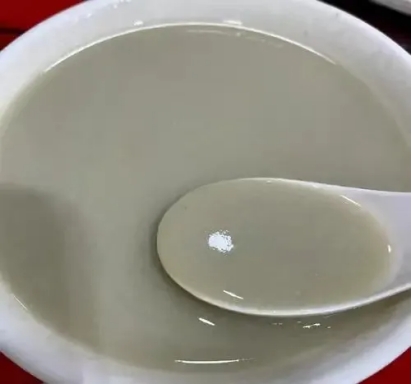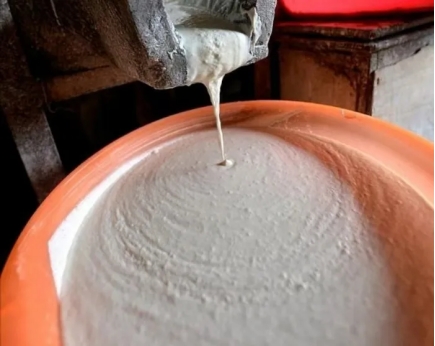导读:北京的豆汁儿,不仅是一种小吃,更是老北京人生活的一部分。但是,有人视其为难得的美味,有人认为它是黑暗的魔鬼料理。那么,如此有争议的食品,是如何诞生的呢?又是用什么做的呢?今天,就让我们一起来了解一下吧!
Douzhi is a traditional drink in Beijing withanuniqueflavor. People who love it can't go a day without it, while those who dislike it often see it as a“dark dish from hell”that they want to avoid at all costs.
北京的豆汁儿是当地一种味道非常独特的传统饮品,喜欢的人特别喜欢,一天不喝都会想念,不喜欢的人则视之如来自地狱的黑暗料理,避之不及。
For many non-locals, trying Douzhi for the first time can be a challenge. But for native Beijingers, it is an essential part of daily life.
很多外地人初次尝试可能难以接受这种味道,但对于老北京人来说,这是他们日常生活中不可或缺的一部分。

Historical Background
历史渊源
The origin of Douzhi can be traced back to the Liao and Song dynasties. It likely began as a byproduct of processing mung beans, originally serving as food for the poor. Over time, through trying various attempts and improvements, it developed into a drink with an unique taste and preparation method.
豆汁儿的起源可以追溯到辽宋时期,最初可能是平民百姓在绿豆在加工过程中产生的一种副产品,最初是作为穷人的食物而存在。后来经过不断尝试和改进,逐渐形成了独特的风味和制作工艺。
During the Qing Dynasty, it is said that Emperor Qianlong loved Douzhi very much. This helped bring Douzhi from common folk to the royal palace. And then Douzhi gained popularity throughout Beijing.
到了清朝,据说乾隆皇帝也非常喜爱豆汁儿,这使得豆汁儿从民间走向了宫廷,进而普及至京城的每一个角落。

Basic Preparation Steps
基本制作工艺
1. Soaking: Clean the mung beans and soak them in water for several hours until the skins can be easily removed.
浸泡:将绿豆清洗干净,用水浸泡若干小时,直到豆皮可以轻易捻掉。
2. Grinding: Grind the soaked mung beans into a fine paste.
磨浆:将泡好的绿豆磨成细浆。
3. Filtering: Add a suitable amount of water to the mung bean paste, and then use cheesecloth to filter the mixture, removing the solid residue and leaving the liquid.
过滤:在磨好的绿豆浆中加入适量清水,用纱布进行过滤,滤去豆渣,保留浆水。
4. Settling: Let the filtered liquid sit overnight. It will separate into layers: foam on top, starch at the bottom, and a slightly thick gray-green liquid in the middle. The middle layer is the raw mung bean milk.
沉淀:将过滤出来的浆水静置一夜,浆水出现分层,表面是浮沫,底层是淀粉,中间一层灰绿色、略为浓稠的浆水,就是生豆汁。
5. Fermenting: Scoop out the raw mung bean milk and add the starter. Allow it to ferment.
发酵:舀出生豆汁,加入发酵剂,进行发酵。
6. Boiling: Boil the fermented mung bean juice until it reaches the desired thickness and flavor. Then it is ready to enjoy.
熬煮:将发酵好的生豆汁进行熬煮,使豆浆达到适宜的浓度和口感,就可以享用了。
Fermentation is a key step in making Douzhi, resulting in the special sour flavor.
发酵是制作豆汁儿的关键步骤,这一过程赋予了豆汁儿其特有的酸香味道。
特点和配食推荐
Douzhi has a gray-green color with clear separation. The top layer is a light green mung bean milk, while the bottom layer is a gray-green sediment.
外观呈灰绿色,有明显的分层现象,上层是淡绿色的豆浆,下层是灰绿色的沉淀。
It has a slight fermented sour smell and tastes sour with a touch of bitterness, finishing with a bit of sweetness.
闻起来有淡淡的酸臭味,喝起来酸中带涩,回味有一点甜。
Traditionally, Douzhi is served with Jiaoquan (a type of fried dough circle) and salted vegetables as breakfast.
传统吃法通常是将豆汁儿与焦圈(一种油炸面食)、咸菜搭配食用,作为早餐。
Conclusion
结语
In Beijing, drinking Douzhi, and pairing it with Jiaoquan and pickles is an unique lifestyle and an important part of traditional Beijing culture. Douzhi, as a reflection of this culture, not only offers a special taste but also allows us to experience the local traditions and folk culture.
在北京,喝豆汁儿、吃焦圈、配咸菜是一种独特的生活方式,也是老北京文化的重要组成部分。豆汁儿作为老北京文化的缩影,不仅让我们品尝到了独特的味道,更让我们感受到了那份属于老北京的风土人情。
文章来源:英语桥文化传播